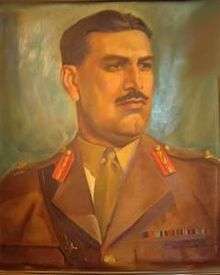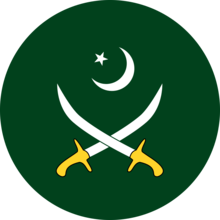Iftikhar Khan
Major General Muhammed Iftikhar Khan (10 January 1907 – 13 December 1949) was an army officer of the British Indian Army and later Pakistan Army.[1] At the time of independence of Pakistan, he was the seniormost Pakistani officer in the Pakistani Army. He was pegged to succeed General Douglas Gracey as the Commander-in-Chief, but unfortunately died in a plane crash before he took office.[2]
Muhammad Iftikhar Khan | |
|---|---|
 Iftikhar Khan's official portrait | |
| Allegiance | |
| Service/ | |
| Years of service | 1929–1949 |
| Rank | Major General |
| Commands held | 7th Light Cavalry 10th Division |
| Battles/wars | World War II Indo-Pakistani War of 1947 |
Early life
Iftikhar Khan belonged to the Minhas Rajput clan of Chakwal. His father Ressaidar retd Raja Fazal Dad Khan was a Zamindar (landowner) and had served as a Viceroy's Commissioned Officer with a British Indian Army cavalry unit. Iftikhar Khan is a younger brother of Pakistan's first General (PA-1) Muhammed Akbar Khan.
Career
After attending the Royal Military College, Sandhurst Iftikhar Khan was commissioned as a Second Lieutenant on the Unattached List for the Indian Army on 29 August 1929.[3] He then spent a year on attachment to the 2nd battalion of the Manchester Regiment.[4]
British Indian Army
He reentered the Indian Army on 16 October 1930 and was posted to the 7th Light Cavalry.[5] He was promoted Lieutenant on 29 November 1931.[6] He then transferred to the 3rd Cavalry on 1 October 1932, a regiment which was then in the process of being Indianised.[7] He was promoted Captain 29 August 1938. He was appointed Quarter Master from 1 August 1937 to 18 April 1938 then the Adjutant of this regiment from 19 April 1938 to 5 August 1940.[8][9][10]
Appointed Staff Captain 7 August 1940.[11][12][13] From 17 December 1941 he was attached to the No. 2 Indian Armoured Corps Training Center.[14] By January 1943 he was a General Staff Officer Grade 2 on the staff of Headquarters Ceylon Army Command.[15] By July 1943 he was a local Lieut-Colonel and a General Staff Officer Grade 2 at the Staff College Quetta.[16] He was still in this role in April 1944[17] In early 1945 he was a temporary Major and second in command of the 45th Cavalry, a war raised armoured unit then serving in Burma, later posted to the 7th Light Cavalry as temporary Major and second in command.[18]
He was promoted Major 29 August 1946. He commanded the 7th Light Cavalry in Japan as part of the Occupation Forces from September to December 1946.[19]
Pakistani Army
On the independence of Pakistan in 1947 he opted to join the Pakistan Army. He was quickly promoted to Major General and on 1 January 1948 assumed the command of 10th Division.[20]
He had been nominated to become the first local Commander in Chief (C-in-C) of the Pakistan Army after General Douglas David Gracey's retirement.[21] He was senior to later Commander-in-Chief and dictator Ayub Khan who later assumed this position and deemed to be a much better professional soldier, though Ayub was commissioned in 1928.[22]
However he died in a Pakistan Airways Dakota which was flying from Lahore to Karachi when it crashed on Karo Jabal, which is near Malmari Jalalji Village, Thatta (in a distance of 102 Kilometers from Karachi) on 13 December 1949 killing him along with Brigadier Sher Khan and 24 others before he could assume the post. He was on his way to Karachi to proceed to England for a course at the Imperial Defence College (IDC, Camberley).[23]
Notes
- January 1931 Indian Army List
- Jalal, Struggle for Pakistan 2014, p. 79.
- London Gazette 30 August 1929 page 5646
- July 1930 Indian Army List
- January 1931 Indian Army List
- April 1934 Indian Army List
- April 1934 Indian Army List
- October 1937 Indian Army List
- July 1940 Indian Army List
- January 1941 Indian Army List
- War services of British and Indian officer of the Indian Army 1941
- January 1941 Indian Army List
- July 1941 Indian Army List
- April 1942 Indian Army List
- January 1943 Indian Army List
- July 1943 Indian Army List
- April 1944 Indian Army List
- October 1945 Indian Army List
- We Lead. 7th Light Cavalry 1784-1990 Edited by Lt-Col C. L. Proudfoot
- Riza, Shaukat. The Pakistan Army 1947-49
- see page 183, The history of Pakistan Army 1947-49 by Maj-Gen Shaukat Riza
- Shaukat Hyat Khan Memoirs Lahore, 1993, np
- Sydney Morning Herald Wednesday 14 Dec 1949
Bibliography
- Abbas, Hassan (2015), Pakistan's Drift into Extremism: Allah, the Army, and America's War on Terror: Allah, the Army, and America's War on Terror, Taylor & Francis, ISBN 978-1-317-46327-6
- Jalal, Ayesha (2014), The Struggle for Pakistan: A Muslim Homeland and Global Politics, Harvard University Press, ISBN 978-0-674-74499-8
- Kapur, Teg Bahadur (2004), Unknown Significant Facts from a Soldier's Diary, Minerva Press, ISBN 978-81-7662-304-9
- Singh, V. K. (2005), Leadership in the Indian Army: Biographies of Twelve Soldiers, SAGE Publications, pp. 160–, ISBN 978-0-7619-3322-9
- Zaheer, Hasan (1998), The Times and Trial of the Rawalpindi Conspiracy, 1951: The First Coup Attempt in Pakistan, Oxford University Press, ISBN 978-0-19-577892-2
Further reading
- Barua, Pradeep. The Army Officer Corps and Military Modernisation in Later Colonial India
- Sharma, Gautam. Nationalisation of the Indian Army
